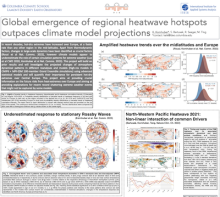Global emergence of regional heatwave hotspots outpaces climate model projections
Kai
Kornhuber
Climate Analytics / Columbia U
Poster
Multiple recent record shattering weather events raise questions about the adequacy of climate models to effectively predict and prepare for unprecedented climate impacts on human life, infrastructure, and ecosystems. While it appears that the record breaking global mean temperatures of 2023 are still within the models spread, we show that climate models fail to reproduce the observed emergence of several heatwave hotspots on impact relevant temporal and spatial scales. We identify several heatwave hotspots worldwide in which the warming of the tail of the distribution outpaces the mean warming. In these regions the observed trends by far exceed what is projected by the multi-model mean of state-of-the-art model frameworks. In multiple regions, observed trends are outside of the model spread and persist irrespective of resolution or model design: We investigate models from HighResMip project (49 members) and CAM6 and the ECHAM5 SST forced large ensemble (60 members) and find that biases persist throughout the vast number of climate model experiments with different architectures (fully coupled and forced with observed SSTs), resolutions (25 km – 250km), and large numbers of realizations (Kornhuber et al. submitted). We discuss potential reasons for the models’ shortcomings. Recently we found that models tend to underestimate the surface anomalies of specific deep atmospheric circulation patterns, which were fundamental to some of the most extreme heat waves in the past (Kornhuber et al. Nat. Comms. 2023). Europe is identified as a heatwave hotspot, driven in part by trends in atmosphere dynamics (Rousi, Kornhuber et al. Nat. Comms. 2022), which models tend to understimate (Vautard et al. Nat. Comms 2023). In addition, non-linear interactions between high pressure, soil moisture deficiencies and temperature have been shown to be pivotal for the record shattering Pacific Northwest heatwave, amplifying its magnitude by 40% (Bartusek, Kornhuber, Ting, Nat. Climate Change 2022). Such dependence structures might not be accurately represented in most models. We conclude that while climate models have been useful and on point regarding their global mean temperature response to increased greenhouse gas concentrations, trends in the far-end tails of the temperature distribution are not well captured, missing emerging high-risk hotspots. This highlights the need to better understand and model the drivers of extreme heat and to rapidly mitigate greenhouse gas emissions to avoid further harm from climate surprises.

Poster file
kornhuber-kai-confronting-poster.pdf
(2.65 MB)
